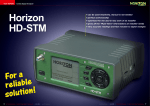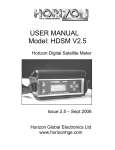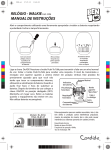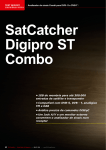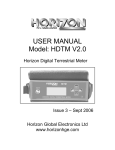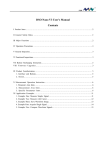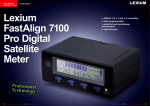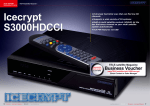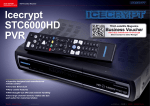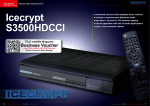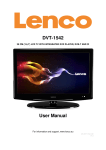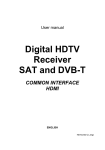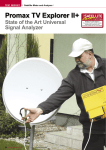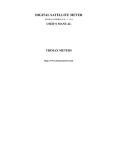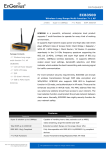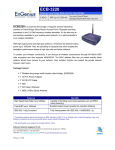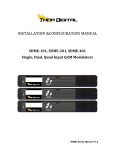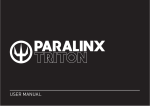Download English - Horizon Global Electronics Ltd.
Transcript
TEST REPORT 该独家报道由技术专家所作 Combo Signal Analyzer Horizon HD-STM 42 TELE-satellite — Global Digital TV Magazine — 12-01/2012 — www.TELE-satellite.com •can be used intuitively, manual is not needed •perfect workmanship •optimized for the day-to-day work of an installer •gives all the "Must-Have" informations an installer needs •very accurate readings and fast reaction to signal changes www.TELE-satellite.com — 12-01/2012 — TELE-satellite — Global Digital TV Magazine 43 TEST REPORT Combo Signal Analyzer Tune Your TV Antenna A Satellite and Terrestrial Meter with a Very Practical and Intuitive User Interface This new signal analyzer is bigger than the other Horizon meters we have tested in TELE-satellite. No wonder, the HD-STM can measure not only satellite DVB-S/S2 signals but also DVB-T and even the old analog TV and FM radio signals. The green case color gives this meter a somewhat military look, but fortunately its case is made of ABS plastic, not metal, and a fully machined Aluminum front panel. Its weight is also quite “civilian”. Definitely, you will not strain your neck when working with the HDSTM at 2kg. The meter sports 10 but- tons: except for the navigation arrows and an OK button in the middle of them, there is an ON/OFF button and four “soft” buttons located near the LCD. Their function depends on the current menu and is always displayed on the screen. The last element on the front panel is the signal input connector. Along with the meter itself, Horizon provided us with a short piece of coaxial cable with F connectors on both ends, then an F-to-IEC adapter and finally 2 pieces of 10 dB signal attenuators for the 5-1000 MHz range. The latter ones come in very handy when measur- ing the output of a terrestrial antenna amplifier. The Horizon HD-STM is also equipped with a car lighter type DC charger, a mains cord with the proper plug for your region and an USB cable. As with every other Horizon meter, you do not need any external power supply unit but connect the mains cord directly to the meter. This is very practical as it saves the hassle with a separate power supply unit, all these items can be stored in the padded case supplied. When you look at the HDSTM from the right side you will notice: a slot for a SD card, the USB port and a DC power supply input to be used with the car charger. The SD card is to be used to log the measurements results. Horizon provides the User Manual in an electronic form – a file in PDF format on the included CD-ROM. We browsed through it and noticed that it is very detailed and written in a simple style illustrated with a huge number of screen-shots. However, for the purpose of this test, we decided not to study it in detail but start using HDSTM right away. In this way, we wanted to check if the user interface was intuitive 12-01/2012 Horizon HD-STM Perfect choice for an installer who values a practical instrument. 44 TELE-satellite — Global Digital TV Magazine — 12-01/2012 — www.TELE-satellite.com 1 2 3 4 5 6 7 8 9 10 11 12 46 TELE-satellite — Global Digital TV Magazine — 12-01/2012 — www.TELE-satellite.com and self explanatory. Right after the welcome screen, you have three menu items: SAT – to measure a satellite signal, TERR – to measure a terrestrial signal and SETUP – to configure the basic settings of the meter. Pressing a soft key (a button near the screen) you make your selection. The very first screen in satellite mode is already a measurement mode. At the top of the screen, you can see the name of the satellite and a signal strength measurement result in two forms: bar graph and numerical. With the left and right arrows, you change the satellite until the HD-STM is able to lock to the signal and shows its parameters: channel power, modulation error ratio (MER) or carrier to noise (C/N), channel bit error rate and post-Viterbi bit error rate. You can also select a desired satellite from the list which is displayed after you press the LIST soft key. For each receivable satellite, HD-STM has at least one transponder stored in its internal memory. In this way, when the meter locks to the transponder, HD-STM “knows” the satellite name. If the factory preprogrammed transponder settings are not enough for you, you can add your own custom transponders. The possibility to manually add more transponder data when needed, without turning to a PC but directly from within the meter menu, is an important asset of the HD-STM. Simpler meters often do not allow this option. If your antenna is not yet set to receive a signal, Horizon’s HD-STM can help you too. Simply switch it to spectrum mode and turn and tilt your dish until you see peaks of signals in the spectrum. Span of the shown spectrum is adjustable in the following steps: 60, 120, 240, 480, 960, 1200 MHz. Once you maximized the peaks in the spectrum view, you return to the previously described measurement screen and by switching the satellite name you identify to which satellite you have just directed your dish. If this is not the desired one, knowing what satellite you are receiving now gives you a good hint what to do with your dish: turn it eastwards or westwards. Once your antenna is looking at the right satellite, you delicately tilt it and slightly turn it left or right to maximize all the readings which the HD-STM is presenting. Meter sensitivity and resolution is exactly as they should be. HD-STM measures channel power with 0.1 dBµV and MER and C/N with 0.1 dB resolution. The HD-STM can be used not only in simple installation with a direct connection to an LNB. The meter is compatible with DiSEqC switches and DiSEqC motors. Thanks to that, you can check if your customer has a problem with a DiSEqC device or perhaps everything is OK with the switches and a motor but the receiver itself does not generate the right DiSEqC commands. The HD-STM can also detect an open circuit and short circuit in the cable connecting it to the LNB. This is also a helpful function. Operating the functions described above is quite simple thanks to the very logical menu structure. The HD-STM can also show the constellation diagram for both QPSK and 8PSK. Having a little experience, you can judge how noisy the signal is just by looking at the graphs. 13 14 15 16 17 18 www.TELE-satellite.com — 12-01/2012 — When we switched the HDSTM to the terrestrial mode, it surprised us by asking in which region of Poland we live and even in the vicinity of which city. That’s because the test sample Horizon provided us with had been customized for Poland. Should it be bought in some other country, it would be customized with the settings suitable for that region. This is quite helpful as you do not have to memorize the channel numbers or frequencies 1. Main menu 2. Satellite finder 3. Spectrum view 4. Span increased to 960 MHz 5. Span decreased to 120 MHz 6. Constellation view (DVB-S2) 7. LNB and cable test result 8. DiSEqC switch submenu 9. DiSEqC motor submenu 10. SD card management screen 11. Setup menu 12. Selecting a region in Poland for terrestrial TV 13. Selecting a city in the region 14. Analog terrestrial channel measurement 15. Digital terrestrial channel (DVB-T) measurement 16. Constellation of a terrestrial signal 17. Setting up power supply for terrestrial antenna amplifiers 18. Logging measurement results in the memory TELE-satellite — Global Digital TV Magazine 47 of the DVB-T multiplexes in different regions. However, nothing prevents the HDSTM to show the whole spectrum, channel after channel, if you so require. But that’s not all. It is Horizon’s policy to make various settings for their meters available on their web page. You just download the most recent settings dedicated to our region and install them in the meter’s internal memory. To do this, you just need to install a simple software that is delivered on the included CD-ROM. Not only terrestrial but also satellite data is updated in this way. The HD-STM can measure both analog and digital terrestrial signals. It can even show constellation diagram for DVB-T. Moreover, you can configure the meter to provide DC voltage for powering mast amplifier. You have a choice of 5, 12 or 18 V DC. The SETUP menu has quite a number of items. Except for typical settings like: the units of channel power (dBµV, dBm or dBmV) or LCD parameters, you can also choose whether to measure MER or C/N for digital satellite signals. We prefer MER as this measurement is less dependent on meter type and brand. Choice of menu language is presently limited to English and French but this is rather not a big problem as most users all over the world are quite familiar with the English terms related to measurement technique. Your measurement results, no matter satellite or terrestrial, can be stored on a SD card as well as downloaded to a PC. Horizon provides the necessary PC software on the included CD ROM. This is applicable not only to the values. You can also capture screens of spectrum or constellation displays. Summarizing the user interface, we are happy to state 48 TELE-satellite — Global Digital TV Magazine — 12-01/2012 — www.TELE-satellite.com More on This Manufacturer Read TELE-satellite’s Company Report: HORIZON that everybody who has just basic orientation in TV signal measurements will practically not need the user manual. Perhaps. you may want to refer to the manual when creating additional transponder entries or to learn how the logging process works but even in these cases most users can do fine without the manual. The HD-STM firmware is really very intuitive. Our test would not be complete if we did not compare the Horizon instrument with analyzers of other brands. We selected two quite complex and expensive meters as our references. We checked the difference in satellite and terrestrial measurements. Two satellites were the sources of signal: HOTBIRD on 13° East (DVB-S2 11278 V transponder) and Atlantic Bird 3 on 5° West (one DVB-S2 and two DVB-S transponders). In terrestrial mode we had one DVB-T carrier and 4 analog carriers available in our location. See the charts in this report. HD-STM performed quite well – its readings were very close to the results shown by the other two meters. In one case, our reference # 2 was unable to lock to the signal (DVB-S 12615H 9180 ks/sec from Atlantic Bird) and it measured only channel power but not MER. But HD-STM had no problem with this signal. Good job! The HD-STM is not a fully fledged signal analyzer but it has most of the features and functions a satellite and terrestrial reception system installers may need. Horizon’s policy with this meter clearly was: to include all “must have” features and to forget all the “nice to have”. Signal Analyzer Manufacturer, UK www.horizonhge.com www.TELE-satellite.com/TELE-satellite-1111/eng/horizon.pdf www.TELE-satellite.com/TELE-satellite-0801/eng/horizon.pdf www.TELE-satellite.com/TELE-satellite-0701/eng/horizon.pdf Workmanship of the Horizon HD-STM is perfect and it is equipped with a high capacity polymer battery. Its satellite and terrestrial performance leaves nothing to be desired. This is a perfect choice for an installer who values a practical instrument. In this way, HD-STM has everything that is really relevant for the installer to do the job fast and easy. Of course, it can not play video and audio of the channel or tell you the bit rate of video or audio, but how many installers are eager to pay for such functions? TECHNICAL DATA Manufacturer Horizon Global Electronics Ltd. Fax+44-1279-417025 [email protected] Web pagewww.horizonhge.com ModelHD-STM Function Satellite and terrestrial antenna meter SATELLITE: RF Input range 950 – 2150MHz 40dBµV to 110dBµV LNB Supply Voltages 13V Vertical 18V Horizontal (21V SCR) LNB Short Circuit Protection 750mA maximum current limiter Transponder memory 4000 definitions Modulation supported QPSK, DSS, Satellite Bands C, Ku and Ka Input dynamic range -70dBm to 0dBm Symbol rate 1Msps – 45Msps QPSK, 8PSK TERRESTRIAL: Channel bandwidth Up to 8 MHz Frequency range 49MHz (VHF) to 861MHz (UHF) Input levels -92dBm to -20dBm Analogue measurements Video and Audio levels Expert Opinion + – 50 TELE-satellite — Global Digital TV Magazine — 12-01/2012 — www.TELE-satellite.com Very intuitive user interface Fast reaction to signal change Good sensitivity and measurement resolution Customized to your country - no useless transponder data to hack through Data logging Non-compliant with DVB-T2 Jacek Pawlowski TELE-satellite Test Center Poland





